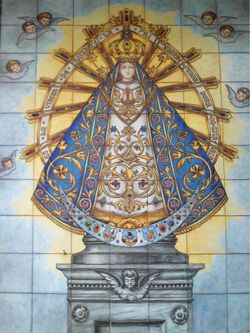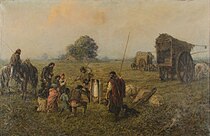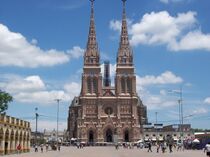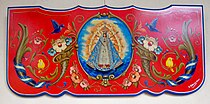Our Lady of Luján
Topic: Religion
 From HandWiki - Reading time: 6 min
From HandWiki - Reading time: 6 min
Our Lady of Luján | |
|---|---|
 | |
| Virgin of Luján, Patroness of Argentina, Uruguay and Paraguay | |
| Venerated in | Roman Catholic Church |
| Major shrine | Basilica of Luján, Argentina |
| Feast | 8 May |
| Attributes | Blessed Virgin Mary in prayer, golden crown, embroidered blue mantle over white robe, sliver of moon |
| Patronage | Argentina , Uruguay, Paraguay, Roman Catholic Archdiocese of Mercedes-Luján, military chaplains |
Our Lady of Luján (Spanish: Nuestra Señora de Luján) is a celebrated 16th-century statue of the Virgin Mary, mother of Jesus Christ. The image, also known as the Virgin of Luján (Spanish: Virgen de Luján), is on display in the Basilica of Luján in Argentina. The feast day of Our Lady of Luján is May 8.
History
The Luján image was made in Brazil and sent to Argentina.[1] Tradition holds that a settler ordered the terracotta image of the Immaculate Conception in 1630 because he intended to create a shrine in her honor to help reinvigorate the Catholic faith in Santiago del Estero, his region.[2] After embarking from the port of Buenos Aires, the caravan carrying the image stopped at the residence of Don Rosendo Oramas, located in the present town of Zelaya.[1]
When the caravan wanted to resume the journey, the oxen refused to move. Once the crate containing the image was removed, the animals started to move again. Given the evidence of a miracle, people believed the Virgin wished to remain there. The image was venerated in a primitive chapel for 40 years. Then the image was acquired by Ana de Matos and carried to Luján, where it currently resides.
Pope John Paul II visited the shrine during an apostolic journey.
Papal honors
Among the Popes who have honored Our Lady of Luján are Clement XI, Clement XIV, Pius VI, Pius IX, Leo XIII, Pius XI, Pius XII, and John Paul II. In 1824, Fr. John Mastai Ferretti visited the shrine on his way to Chile. He later became Pope Pius IX and defined the dogma of the Immaculate Conception on December 8, 1854.
Because of the reputation of the shrine, Pope Leo XIII decided in 1886 to honor the miraculous statue with a Canonical Coronation. On September 30 of that year, he blessed the crown, which was made of pure gold and set with 365 diamonds, rubies, emeralds and sapphires, 132 pearls and a number of enamels depicting the emblems of the Archbishop and the Argentine Republic. The papal coronation of Our Lady of Luján took place on May 8, 1887. The celebrant chosen by the Pope for this event was Archbishop Federico León Aneiros who at that time made a pilgrimage in thanksgiving to Our Lady for sparing his archdiocese from the scourge of cholera.
On 8 September 1930, Pope Pius XI formally declared Our Lady of Lujan as the Patroness of Argentina , Paraguay and Uruguay. The Papal document was signed by Cardinal Eugenio Pacelli, the future Pope Pius XII. [3]
Cardinal Eugenio Pacelli served as the Papal Legate to the XXXII International Eucharistic Congress held in Buenos Aires in October 1934, and visited the Basilica on October 15. When he became Pope Pius XII, he made a radio address to the pilgrims in Luján on the occasion of the First Marian Congress in Argentina in 1947.
In 1982, during the Falklands War, John Paul II became the first pope to visit Our Lady of Luján. During this visit the Pope celebrated an outdoor Mass in the square of the Basilica of Our Lady of Luján and bestowed upon her the Golden Rose. Both in his homily of June 11 and his Angelus back in Rome reflecting on the trip, he commented on Our Lady's never failing maternal solicitude for the faithful in times of distress. Sixteen years later in Rome, John Paul II gave a replica of the image to the Argentine National Parish during his pastoral visit there.
The Golden Rose
The Golden Rose is a gift from the Pope to nations, cities, basilicas, sanctuaries, or images. It is blessed by him on the fourth Sunday of Lent, anointed with the Holy Chrism, and dusted with incense. This Rose consists of a golden rose stem with flowers, buds and leaves, placed in a silver vase lined on the inside with a bronze case bearing the Papal shield. Pope Leo IX is considered as the originator of this tradition in the year 1049.
In the Americas, the Rose has been given to Our Lady of Guadalupe in Mexico, to Our Lady of Aparecida in Brazil , to St. Joseph's Oratory in Canada, to the Basilica of the National Shrine of the Immaculate Conception in the United States, to the Cathedral Basilica of Nuestra Señora del Valle in Argentina and to the Basílica Santuario Nacional de Nuestra Señora de la Caridad del Cobre in Cuba. On June 11, 1982, John Paul II personally bestowed a Golden Rose on Our Lady of Luján.
See also
- Ahí tienes a tu Madre (film)
- Basilica of Our Lady of Luján
- Blessed Virgin Mary
- Maravilla Americana
- Marian apparitions
- Penance
- Pope Francis
- Roman Catholicism
References
- ↑ 1.0 1.1 "Argentina: Our Lady of Luján," http://campus.udayton.edu/mary/resources/engone.html Retrieved 7 April 2013
- ↑ "Our Lady of Lujan" from Zsolt Aradi, Shrines to Our Lady, 1954, http://www.catholicculture.org/culture/library/view.cfm?recnum=3181, accessed 7 April 2013
- ↑ Pius XI, Papam. ARGENTINAE REIPUBLICAE, ITEMQUE URUGUAYANAE ET PARAGUAYANAE CAELESTIS PATRONA DECLARATUR BEATA VIRGO MARIA IMMACULATA, SUB TITULO « DE LUJAN ». PIUS PP. XI Ad perpetuam rei memoriam. — Argentinae Reipublicae intra fines in civitate Lujan nuncupata, conspicua exstat imago Beatae Mariae Virginis Immaculatae quam christifideles non modo regionis Argentinae sed finitimarum quoque de Uruguay ac de Paraguay Rerumpubücarum sub titulo Nostrae Dominae de Lujan a tribus saeculis continenti pietate devotioneque maxima venerantur. Iam Decessores Nostri, precibus Episcopi de Plata benigne concedentes, ipsam Nostram Dominam de Xtujan dioecesis de Plata principalem Patronam declararunt, eiusdemque festum cum officio et Missa propriis atque adprobatis die VII mensis Februarii quotannis celebrandum statuerunt. Hodiernus vero Episcopus de Plata nomme quoque aliorum sexdecim Antistitum seu Ordmariorum, qui in memoratis Rebuspublicis dominicum fidelium gregem moderantur, humillimis enixis que supplicationibus Nos rogat, ut eadem Beata Virgo Immaculata de Lujan, principalis tum Argentinae tum Uruguayanae tum Paraguayanae Reipublicae Patrona declaretur et constituatur. Nos autem ad magis magisque in dies fovendam et augendam earundem regionum populi venerationem ac pietatem erga Beatissimam Mariam Virginem Immaculatam de Lujan, huiusmodi votis ultro libenterque annuendum censuimus. Audito igitur dilecto filio Nostro Sanctae Romanae Ecclesiae Cardinali Sacrorum Rituum Congregationi Praefecto, omnibus rei momentis sedulo studio perpensis, Litterisque attentis postulatoriis Archiepiscoporum, Episcoporum ceterorumque Antistitum Rerumpublicarum earundem, motu proprio atque ex certa scientia ac matura deliberatione Nostris deque apostolicae Nostrae potestatis plenitudine, praesentium Litterarum tenore perpetuumque in modum Beatissimam Virginem Mariam Immaculatam sub enunciato titulo de Lujan nuncupatam triplicis Argentinae, Uruguayanae et Paraguayanae Reipublicae praecipuam apud Deum Patronam declaramus et constitiumus; indulta prius pro hac benigna Nostra concessione dispensatione a consueta forma, quae per Decretum Sacrae Rituum Congregationis «De Patronis in posterum eligendis » praescripta est. Decernimus praeterea eadem Nostra auctoritate, Litterarum praesentium vi itemque in perpetuum, ut festum eiusdem Sanctissimae Patronae quotannis die VII mensis Februarii, sub Acta Pii PP. XI 157 ritu duplici primae classis cum octava communi et Officio ac Missa propriis et iam adprobatis pro dioecesi de Plata, recolatur. Haec vero mandamus atque edicimus, decernentes praesentes Litteras firmas, validas atque efficaces semper exstare ac permanere, suosque plenos atque integros effectus sortiri atque obtinere; illisque ad quos pertinent, sive pertinere poterunt, nunc et in posterum perpetuo suffragari; sicque rite iudicandum esse ac definiendum; irritumque ex nunc et inane fieri, si quidquam secus super his, a quovis, auctoritate qualibet, scienter sive ignoranter attentari contigerit. Contrariis non obstantibus quibuslibet. Datum Romae apud Sanctum Petrum, sub anulo Piscatoris, die VIII mensis Septembris anno MDCCCCXXX, Pontificatus Nostri nono. E. CARD. PACELLI, a Secretis Status.
External links
| Wikimedia Commons has media related to Our Lady of Luján. |
- Our Lady of Lujan from Zsolt Aradi, Shrines to Our Lady, 1954
- Lujan Argentina
- Virgen de Luján
- Marcelo Pisarro, "La lujanera tropezó", en Nerds All Star, Revista Ñ, Diario Clarín, Buenos Aires, 26 de octubre de 2009.
- Parroquia Nuestra Señora de Luján de Longchamps
- Grupo Scout Nº 1 Nuestra Señora de Luján de Longchamps
- Centro Nuestra Señora de Luján de Longchamps
- Diseñan un dispositivo especial para proteger la imagen de la Virgen
- Papal honors, our lady of luján and the Golden Rose
 |
 KSF
KSF



